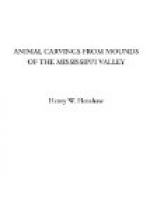To trace the origin of art among primitive peoples, and to note the successive steps by which decorative art grew from its probable origin in the readily recognized adornments of nature and in the mere “accidents of manufacture,” as they have been termed, would be not only interesting, but highly instructive. Such a study should afford us a clew to the origin and significance of conventional as contrasted with imitative art.
The natural process of the evolution of art would seem to be from the purely imitative to the conventional, the tendency being for artistic expression of a partially or wholly imaginative character to supplant or supplement the imitative form only in obedience to external influences, especially those of a religious or superstitious kind. In this connection it is interesting to note that even among tribes of the Northwest, the Haidahs, for instance, whose carvings or paintings of birds and animals are almost invariably treated in a manner so highly conventional or are so distorted and caricatured as to be nearly or quite unrecognizable, it is still some natural object, as a well known bird or animal, that underlies and gives primary shape to the design. However highly conventionalized or grotesque in appearance such artistic productions may be, evidences of an underlying imitative design may always be detected; proof, seemingly, that the conventional is a later stage of art superimposed upon the more natural by the requirements of mythologic fancies.
As it is with any particular example of savage artistic fancy, so is it with the art of certain tribes as a whole. Nor does it seem possible that the growth of the religions or mythologic sentiment has so far preceded or outgrown the development of art as to have had from the first a dominating influence over it, and that the art of such tribes as most strongly show its effect has never had what may be termed its natural phase of development, but has reached the conventional stage without having passed through the intermediate imitative era.
It is more natural to suppose, so far, at least as the North American Indians are concerned, that the road to conventionalism has always led through imitation.
The argument, therefore, that because a tribe or people is less given than another to conventional methods of art, it therefore must necessarily be in a higher stage of culture, is entitled to much less weight than it has sometimes received. Squier and Davis, for instance, referring to the Mound-Builders, state that “many of these (i.e., sculptures) exhibit a close observance of nature such as we could only expect to find among a people considerably advanced in the minor arts, and to which the elaborate and laborious, but usually clumsy and ungraceful, not to say unmeaning, productions of the savage can claim but a slight approach.”




